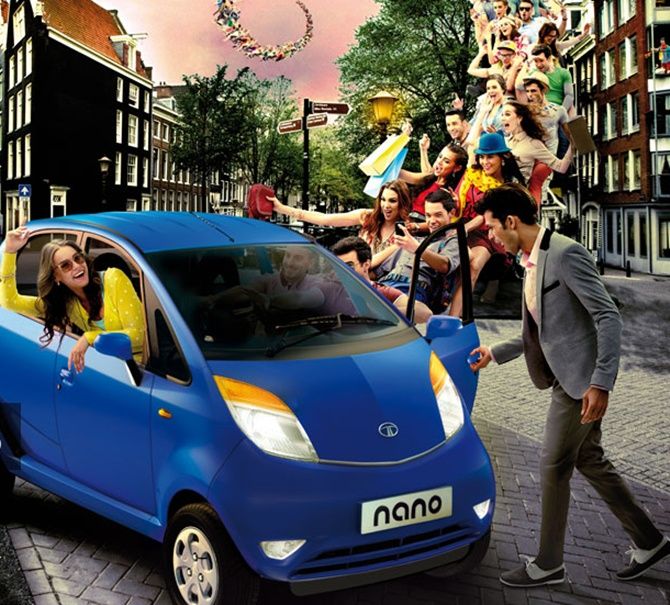Broad figures will tell you that almost half of that market is in India's villages, notes Shailesh Dobhal.
 Reading what Ratan Tata, chairman emeritus of Tata Sons, is reported to have said late last year set me thinking on the paradigm of consumption in India.
Reading what Ratan Tata, chairman emeritus of Tata Sons, is reported to have said late last year set me thinking on the paradigm of consumption in India.
Tata, speaking at an event organised by Frost & Sullivan, a consultancy, said that carmakers in India should introspect why the market here is just over three million, compared to China's 15-18 million.
"We need to ask ourselves have we made cars too expensive for consumers to own. Have we focused on a low-scale, high-margin business," he is reported to have said.
Tata should know, for even after engineering the world's cheapest car, the Nano, sales fail to take off as expected, but that's another story for another day.
With penetration of anything form cars to colas still low in global comparisons - just two in a thousand Indians own a car and even soft drinks reach just one in five people across the country - the obvious stares us in the face: that we as people and a country have just about embarked on the consumption gravy train. Can it, so early in its journey, derail as some recent reports seem to suggest?
Take the Rs 3 lakh-crore market for consumer expendables such as soaps, shampoos, packaged tea, and face creams, for instance. Broad figures will tell you that almost half of that market is in India's villages.
And recent reports have started focusing on flagging growth there, what with crop prices being low and the impact of government-sponsored employment scheme petering out.
That may well be true, but look at where the bulk of this consumption is happening right now, and you'll know where the market should be headed.
A recent report by leading market research agency Nielsen India, 'Rise Of The Rural Super Consumer', tells us that almost three-fourths (72 per cent) of rural consumer expendables consumption is accounted by just 10 states.
And over two-thirds (66 per cent) of soft drink sales in rural India happens in just 19,000 villages.
Clearly, the other 19 states and 611,000-odd villages are not consuming enough. The reasons may vary - from low purchasing power and a lack of access to branded products to a lack of basic utilities that enable consumption such as electricity, tarred roads and piped water.
The country's largest consumer firm, Hindustan Unilever, reaches just over a third of the eight-million odd retail stores, so penetration-led growth has some legs left to go.
Several studies have pointed to a link between growth, development and consumption.
Though this government's focus on providing 24x7 electricity, public investment in infrastructure and Swachh Bharat will certainly take time to show results, and there will be many a missed milestones, a large, concomitant impact on economy-wide consumption is also a foregone conclusion.
Now, everyone from the World Bank, the International Monetary Fund to sundry market participants have flagged that India's growth may have bottomed out and barring geo-political upheaval or a Black Swan event, it is headed up.
It is important to note that agriculture growth, the bulwark of the rural economy, has held on, growing 3.5 per cent in the first half of the fiscal year ending March.
That, coupled with commodity prices in cyclical lows and consequently historically low consumer price inflation, will start impacting consumption positively, albeit with a lag of a quarter or two.
Something that the chief executive of the country's biggest consumer expendables firm, Hindustan Unilever, acknowledged while presenting far from robust sales figures for quarter ending December 2014.
"The slowdown has bottomed out, and from the next quarter or so we should see volumes pick up across segments," Sanjiv Mehta had said.
And with growing consumer confidence, the market for consumer expendables will return to double-digit growth this year, according to Nielsen, the country's largest retail audit firm.
It is true that growth in the sales of cars, two-wheelers and commercial vehicles in the last 12 months has been tepid, but falling fuel prices, lower interest rates and general pick-up in economic activity will impact the sector positively.
Already, in December 2014, the last month for which data is available, car sales had jumped 15 per cent, two-wheelers 4.5 per cent and commercial vehicles 9 per cent.
The Private Final Consumption Expenditure, a measure of what households and individuals spend on all goods and services, for quarter ended September 2014 grew at 5.8 per cent (at 2004-05 market prices terms), higher than 5.6 per cent for June 2014, and in stark contrast to the almost decadal lows of 2.8 per cent and 1.6 per cent for September and June 2013 respectively.
Hardly the stuff that would strengthen the chorus of the demand-destruction-is-upon-us alarmists!











